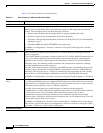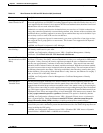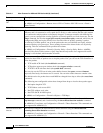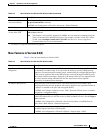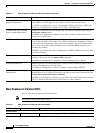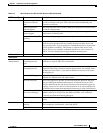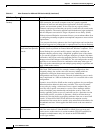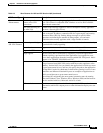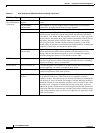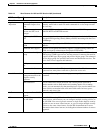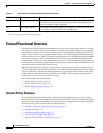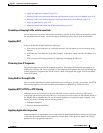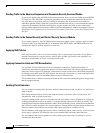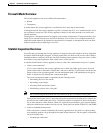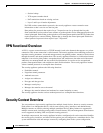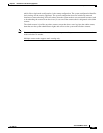
2-14
Cisco ASDM User Guide
OL-16647-01
Chapter 2 Introduction to the Security Appliance
New Features by Platform Release
Browser-based
SSL VPN Features
(continued)
Personal bookmark
support
Users can define their own bookmarks. These bookmarks are stored on a file
server.
Transformation
enhancements
Adds support for several complex forms of web content over clientless
connections, including Adobe flash and Java WebStart.
IPv6 Allows access to IPv6 resources over a public IPv4 connection.
Web folders Lets browser-based SSL VPN users connecting from Windows operating
systems browse shared file systems and perform the following operations:
view folders, view folder and file properties, create, move, copy, copy from
the local host to the remote host, copy from the remote host to the local host,
and delete. Internet Explorer indicates when a web folder is accessible.
Accessing this folder launches another window, providing a view of the
shared folder, on which users can perform web folder functions, assuming the
properties of the folders and documents permit them.
Microsoft Sharepoint
enhancement
Extends Web Access support for Microsoft Sharepoint, integrating Microsoft
Office applications available on the machine with the browser to view,
change, and save documents shared on a server. Version 8.0(2) supports
Windows Sharepoint Services 2.0 in Windows Server 2003.
HTTP Proxy PAC support Lets you specify the URL of a proxy autoconfiguration file (PAC) to
download to the browser. Once downloaded, the PAC file uses a JavaScript
function to identify a proxy for each URL.
HTTPS Proxy Proxy exclusion list Lets you configure a list of URLs to exclude from the HTTP requests the
security appliance can send to an external proxy server.
NAC SSL VPN tunnel support The security appliance provides NAC posture validation of endpoints that
establish AnyConnect VPN client sessions.
Support for audit
services
You can configure the security appliance to pass the IP address of the client
to an optional audit server if the client does not respond to a posture
validation request. The audit server uses the host IP address to challenge the
host directly to assess its health. For example, it might challenge the host to
determine whether its virus checking software is active and up-to-date. After
the audit server completes its interaction with the remote host, it passes a
token to the posture validation server, indicating the health of the remote host.
If the token indicates the remote host is healthy, the posture validation server
sends a network access policy to the security appliance for application to the
traffic on the tunnel.
Table 2-5 New Features for ASA and PIX Version 8.0(2) (continued)
ASA Feature Type Feature Description



